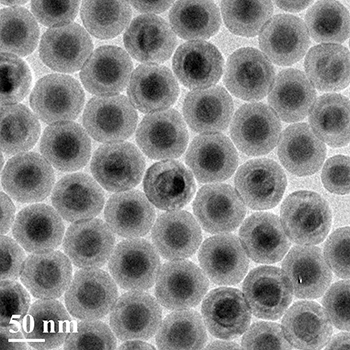
New onion-like nanoparticles efficiently convert near-infrared light to blue and ultraviolet light. Each particle is about 50 nm in diameter. Credit: Institute for Lasers, Photonics and Biophotonics, University at Buffalo
An international team of researchers demonstrate a proof-of-concept “onionesque” multilayered nanoparticle for efficient three-photon upconversion of near-infrared (NIR) light to blue or ultraviolet light. The nanoparticle consists of an ytterbium and thulium core, a neodymium shell and an organic dye coating. The layers work together to enable a multistep energy-cascaded transfer that yields a multiphoton upconversion quantum efficiency as high as 19 percent. The researchers say that their nanoparticle design could improve a broad range of photonic applications, including deep-tissue imaging and security inks used in money printing (Nano Lett., doi: 10.1021/acs.nanolett.5b02830).
Each of the three layers in the onion-like nanoparticle work together to help transfer energy efficiently from the surface to the light-emitting core. The outermost layer of organic dye acts as an antenna to absorb low-energy photons from NIR light (700 to 850 nm) and transfers their energy to the middle shell layer. The shell, which contains neodymium, transfers energy from the organic dye into the core. Neodymium ions have an excited state between the ions in the outer layer and the core, allowing them to act as a stepstool, making it easier for energy captured by the organic dye to reach the core. Ytterbium ions in the core collect energy from the shell and pass it to the thulium ions. The thulium ions absorb energy from several photons at once and then emit a single high-energy photon of blue or UV light (i.e., three-photon upconversion).
In a press release, co-author Jossana Damasco from the State University of New York, Buffalo (USA), says: “Our particle is 100 times more efficient at ‘upconverting’ light than similar nanoparticles created in the past, making it much more practical.”
